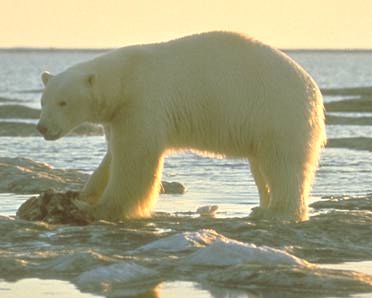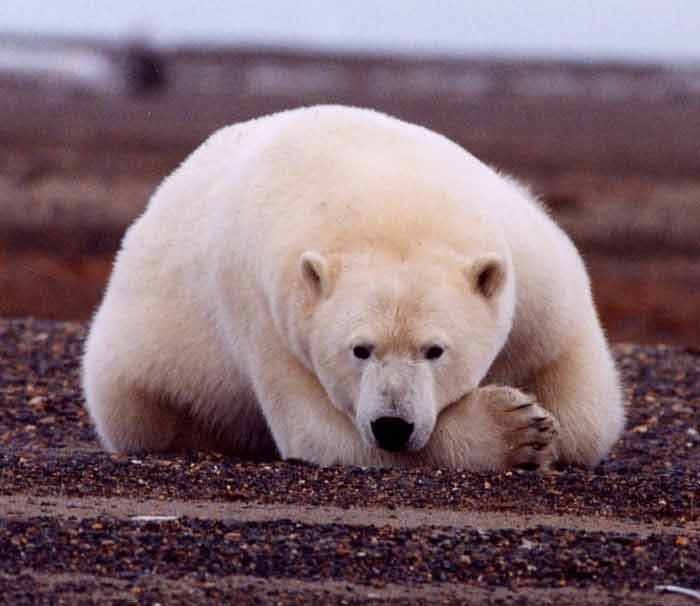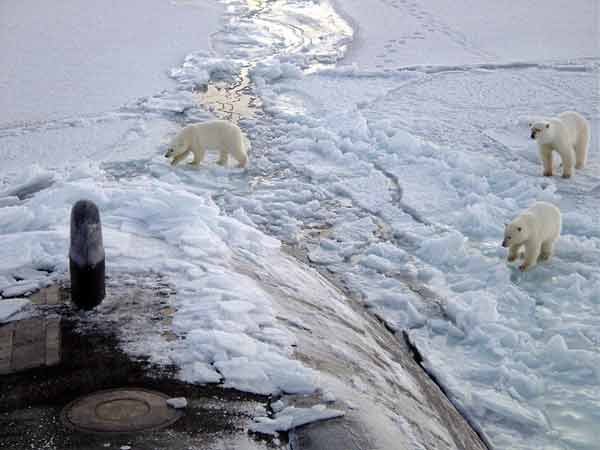Polar Bear
The polar bear (scientific Latin name Ursus maritimus), also known as white bear or northern bear, is a large mammal of the order Carnivora (meat eater), family Ursidae (bears). It is a circumpolar species found in and around the Arctic Ocean and is the world's largest land carnivore. Adult males weigh from 400 to 600 kg (900 to 1300 lbs) and occasionally exceed 800 kg (1750 lbs). Females are about half the size of males and normally weigh 200–300 kg (450 - 650 lbs). Adult males measure 2.4 to 2.6 m; females, 1.9 to 2.1 m. At birth, cubs weigh 600 to 700 g. Population estimates range from 16,000 to 35,000, with about 60% in Canada.
The polar bear is instantly recognisable by its white-coloured coat. Unlike other arctic mammals, it never sheds this coat for a darker colour in the summer. The hair is not actually pigmented white; it is unpigmented and hollow, like white hair in humans. Neither does the hair have fibre-optic properties, a commonly perpetuated urban legend.

Polar bears are well insulated to the point where they overheat at temperatures above 10°C (50°F). Their insulation is so effective that when viewed with infrared camera they are barely visible. Only the pads of their feet emit detectable heat.
It is the most completely carnivorous member of the bear family and feeds mainly on seals. Polar bears are excellent swimmers and can often be seen in open waters miles from land. This may be a sign that they have begun aquatic adaptations to better catch their prey. They also hunt very efficiently on land due to their prodigious speed; they are more than capable of outrunning a human. Other prey include beluga whales, walruses and rodents. As a pure carnivore predating upon fish-eating carnivores, the polar bear ingests large amounts of Vitamin A, which is stored in its liver: in the past, humans have been poisoned by eating liver of polar bears. Contrary to popular belief, polar bears do not eat penguins: this is because polar bears live at the North Pole, and penguins live (primarily) at the South Pole.
Polar bears are believed to be threatened, not mainly by hunting, but by habitat loss caused by global warming; for example, the area of ice covering Hudson Bay in Northern Canada in winter is shrinking, limiting their access to seal prey. The sensitivity of the survival rates of the bears to global temperature was documented by the population bulge in the cohort of bears born during the transient cooling that followed the eruption of Mount Pinatubo in 1991. However, it turned out that the population of polar bears grew by unprecedented 15–25 percent between 1995 and 2005. The decrease in several regions was caused by hunting, not by climate change.

An interesting feature of the coat is that it appears black when photographed with ultraviolet light. A number of people have suggested that this is because the hairs channel the light to the black skin of the bear to help it stay warm during the cold, sunless winters. Measurements show, however, that the hairs strongly absorb violet and ultraviolet rays. This is why the polar bear's pelt often appears yellow. More colourful polar bears have occasionally been reported. In February 2004, two polar bears in the Singapore Zoo appeared to turn green as a result of algae growing in their hollow hair tubes. A zoo spokesman said that the algae had formed as a result of Singapore's hot and humid conditions. The bears were washed in a peroxide blonde solution to restore their expected colour. A similar algae grew in the hair of three polar bears at San Diego Zoo in the summer of 1979. They were cured by washing the algae away in a salt solution.
Polar bears are known for their comical and often photogenic recreational activities. For example, they slide on their bellies, box with each other, and dunk one another underwater. When the female makes her den she makes it on a hillside so her cubs can slide down the hill on their bottoms, a feature commonly depicted in cartoons and other fictional depictions of polar bears, including a 1990s Coca-Cola ad campaign.

Three Polar bears approach the starboard bow of the Los Angeles-class fast attack submarine USS Honolulu
A polar bear is depicted on Canada's $2 toonie coin. It is the mascot of at least two American schools, Bowdoin College, and Ohio Northern University.